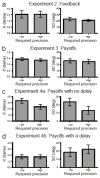The number and quality of representations in working memory
- PMID: 21987693
- PMCID: PMC3218797
- DOI: 10.1177/0956797611417006
The number and quality of representations in working memory
Abstract
Flexible-resource theories characterize working memory as a flexible resource that can store either a large number of low-quality representations or a small number of high-quality representations. In contrast, limited-item theories propose that the number of items that can be stored in working memory is strictly limited and cannot be increased by decreasing the quality of the representations. We tested these fundamentally different conceptualizations of working memory capacity by determining whether observers could trade quality for quantity in working memory when given incentives to do so. We found no evidence that observers could increase the number of representations by decreasing their quality in working memory, but observers could make such a trade-off at earlier processing stages. Our results show that the capacity limit of working memory is best characterized as a limit on the number of items that can be stored and not as a limit on a finely divisible resource that simultaneously determines the number and quality of the representations.
Figures


References
-
- Alvarez GA, Cavanagh P. The Capacity of Visual Short-Term Memory Is Set Both by Visual Information Load and by Number of Objects. Psychol Sci. 2004;15(2):106–111. - PubMed
-
- Alvarez GA, Franconeri SL. How many objects can you track? Evidence for a resource-limited attentive tracking mechanism. Journal of Vision. 2007;7(13):14, 11–10. - PubMed
-
- Atkinson RC, Juola JF. Factors influencing the speed and accuracy of word recognition. In: Kornblum S, editor. Attention and performance. IV. New York: Academic Press; 1973. pp. 583–612.
-
- Atkinson RC, Juola JF. Search and decision processes in recognition memory. In: Krantz DH, Atkinson RC, Luce RD, Suppes P, editors. Comtemporary developments in mathematical psychology: Vol 1. Learning, memory & thinking. San Francisco, CA: Freeman; 1974. pp. 243–290.
Publication types
MeSH terms
Grants and funding
LinkOut - more resources
Full Text Sources

